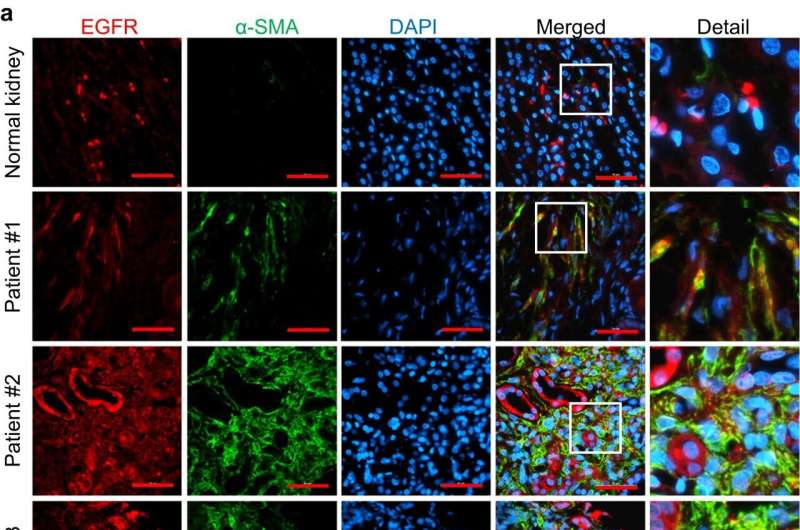This article has been reviewed according to Science X's editorial process and policies. Editors have highlighted the following attributes while ensuring the content's credibility:
fact-checked
peer-reviewed publication
trusted source
proofread
Scientists discover key step to kidney fibrosis

Researchers at Vanderbilt University Medical Center for the first time have shown that activation of the epidermal growth factor receptor (EGFR) is essential for the development of kidney fibrosis, tissue scarring following injury that can lead to kidney failure.
Their discovery, reported Nov. 14 in the journal Nature Communications, could lead to the first effective treatment for kidney fibrosis, and may provide insight into the development of fibrosis in other organs, including the pancreas, lung and liver, and in other conditions.
Epidermal growth factor and its receptor, which stimulate the growth of epidermal tissue, were discovered more than 60 years ago by the late Stanley Cohen, Ph.D., a Nobel Prize-winning biochemist at VUMC who died in 2020. Today EGFR is the target for a growing number of cancer drugs.
Previous studies have implicated the EGFR signaling pathway in the development of kidney fibrosis, but until now the underlying mechanisms leading to fibrosis had not been determined.
The paper's co-corresponding authors, Ming-Zhi Zhang, MD, MSc, and Raymond C. Harris, MD, have had a longstanding interest in understanding the mechanism underlying progressive kidney fibrosis and failure.
The VUMC researchers focused on pericytes and fibroblasts, cells essential to the formation and functioning of the basement and extracellular membranes, which provide structural and biochemical support to tissues, including the kidney.
Recent studies indicate that following acute kidney injury, pericytes and fibroblasts migrate, proliferate and ultimately differentiate into myofibroblasts. These cells are involved in the fibrotic scarring of the tubules, which in the kidney are key structures for the removal of waste products from the bloodstream.
In a mouse model, the researchers showed that EGFR activation was necessary for the migration and proliferation of kidney fibroblasts and pericytes prior to their transformation into myofibroblasts. Selectively deleting EGFR from the two cell populations inhibited the development of fibrosis following acute kidney injury.
At the molecular level, EGFR activation is triggered by an enzyme called ADAM17, which cleaves EGF and other ligands that bind to the receptor. ADAM17, in turn, is turned on by iRhom2 intramembrane proteins.
Targeting iRhom2 could be one way to block EGFR activation. Another possible target is a related receptor called ErbB4, which, when activated in fibroblasts, potentially may counter the effects of EGFR activation, the researchers said.
Further studies will be needed to confirm these hypotheses.
More information: Shirong Cao et al, Epidermal growth factor receptor activation is essential for kidney fibrosis development, Nature Communications (2023). DOI: 10.1038/s41467-023-43226-x



















